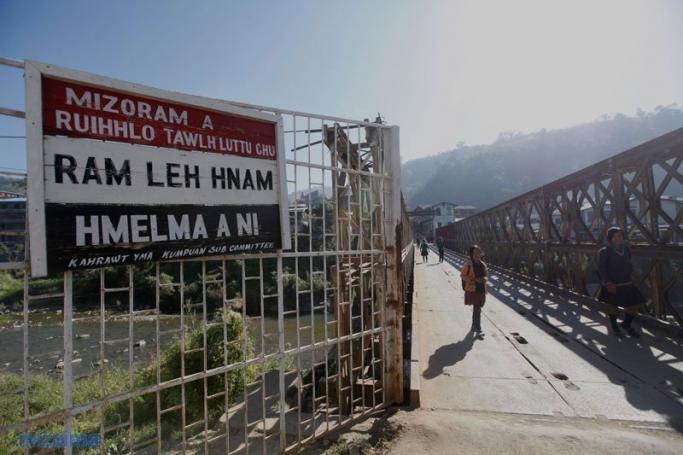In August 2016, after President U Htin Kyaw concluded a four-day state visit to India, the two countries signed four MOUs and released a joint statement. While the statement, which ran to thirty clauses, touched on relevant points in bilateral relations, it also shone a light on what Myanmar and India need to work on to cement those relations.
Two countries which share a 1,600 km land border have a long history of cultural, political, and economic linkages. Under the colonial period, the joint British administration of India and Burma led to close legal, commercial, and migratory ties between the two countries. Even today, such ties manifest themselves within the popularity of Indian food, music, and movies in Myanmar. Cultural artefacts like longyis were imported from India and shared linguistic bonds still can be observed in common vocabulary used on both sides of the border, such as aloo (potato) and gobi (cabbage).
While India wants to cooperate with Myanmar as part of its "Act East" policy to gain influence and market share in ASEAN, the two countries’ relationship is largely underdeveloped. Myanmar has significantly stronger links with its two other neighbours, Thailand and China – through FDI, trade, and tourism, than with India. Myanmar's trade with China in FY2015 was US$9.6 billion and with Thailand was $5.7 billion, whereas trade with India is only $1.3 billion. Likewise, India is only the 9th biggest FDI investor in Myanmar – representing only 1.36% of total FDI invested into Myanmar.
There are several reasons for this. The two countries' economic relationship, especially border trade, has suffered from the lack of clear and consistent policy on both sides of the border. High tariffs from the Indian side also make the country an unattractive market for Myanmar exporters. Logistical challenges are daunting due to lack of physical linkages and poor infrastructure between the two countries. Both countries score poorly on the ease of trading across border index by the World Bank. Air and sea linkages between the two countries are limited. Only two cities in India are connected by air to Myanmar, and the number of Indians visiting Myanmar (and vice versa) remains a fraction of those who travel to China and Thailand.
To overcome these challenges, two policies are apparent. Myanmar and India should put an emphasis on developing the port of Sittwe, on the Bay of Bengal. India has recently announced a multi-billion-dollar plan to develop Chabahar Port and Trade Zone in Iran, to compete with a nearby China-backed port in Pakistan. This recent example suggests that the Indian government is open to investing in strategically important assets. Sittwe is such an asset, as it is a port city close to Chinese-backed special economic zone at Kyauk Phyu. During President U Htin Kyaw’s visit, the two countries agreed that the completed facilities at Sittwe will be operational by December 2016. Beyond this, logistics, processing, and manufacturing facilities can be sited at Sittwe to serve bilateral trade.
Another policy option is for Myanmar to strengthen institutional support for exports and imports. This involves Myanmar negotiating a preferential trade agreement with India, with an emphasis on agricultural and border trade, and taking advantage of existing structures such as Exim Bank of India. In the longer run, a local Myanmar Export-Import Bank should be established to bolster the country’s trade links with the wider world.
Myanmar's economic linkages with its eastern neighbours, China and Thailand, are already robust even during the years of isolation. Now, it is time for Myanmar to forge similar linkages with India. Due to historical and cultural ties with India, Myanmar has a great chance to learn from and grow with its giant neighbour to the west. For India, Myanmar is a test-case for and an opportunity to truly implement its “Act East” policy.
Shine Zaw-Aung graduated from Stanford University, California in 2011 with Honors in International Relations. At Stanford, he was a Senior Class Fellow at Center for International Security and Cooperation (CISAC). After the graduation, he worked as a business and economic consultant for multinational companies in the United States, Europe, and South East Asia. He is a co-founder of First Rangoon Corporation, a business consultancy firm advising local Myanmar companies on accounting and finance procedures.
His paper on “Myanmar-India Relations - Trade and Economic Perspectives” has been published online by the Myanmar Institute of Strategic and International Studies (MISIS) as part of a joint project by MISIS and the Norwegian Institute of International Affairs. It can be accessed through www.myanmarisis.org.
You are viewing the old site.
Please update your bookmark to https://eng.mizzima.com.
Mizzima Weekly Magazine Issue...
14 December 2023
Spring Revolution Daily News f...
13 December 2023
New UK Burma sanctions welcome...
13 December 2023
Spring Revolution Daily News f...
12 December 2023
Spring Revolution Daily News f...
11 December 2023
Spring Revolution Daily News f...
08 December 2023
Spring Revolution Daily News f...
07 December 2023
Diaspora journalists increasin...
07 December 2023
PPP candidate interested in extracting resources from mountains east of Pyinmana












